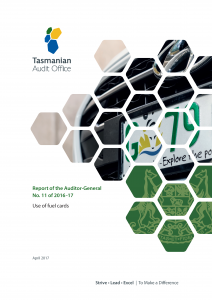About this report or communique
 Report of the Auditor-General No. 11 of 2016-17
Report of the Auditor-General No. 11 of 2016-17
Use of fuel cards
Tasmanian General Government Sector entities (GGS entities) use fuel cards to purchase fuel for their light passenger and commercial vehicle fleets.
The use of government vehicles, including the consumption of fuel, is subject to considerations such as appropriate standards of probity, propriety and accountability.
The Department of Premier and Cabinet (DPAC) issued a “Policy and Guidelines for the Allocation and Use of Motor Vehicles within the State Service”. The policy applied to all State Service agencies in respect of all government owned and operated vehicles.
The objective of this examination was to assess the probity and propriety of the use of fuel cards.
The examination covered transactions for the 2015 calendar year (1 January 2015 to 31 December 2015). The examination covered all GGS entities that used fuel cards.
The examination criteria by major category are as follows:
Fuel card purchases
- fuel purchased incompatible to assigned vehicle requirements
- multiple fuel purchases made within two hours, on same day or within 50 kilometres
- prohibited items purchased and charged to the fuel card
- amount of fuel (in litres) purchased above the fuel tank capacity of the assigned vehicle
- fuel purchases made on non-working days, including public holidays, or at unusual times (excluding vehicles operated on a 24/7 basis and private plated cars).
Fuel card controls
- correct odometer reading provided or entered when refuelling, including readings
- not provided or entered as zero
- entered as the same value more than once
- entered less than 100 kilometres
- greater than 60 000 kilometres
- entered as a default code such as ‘777’
- out of sequence.
- whether security PINs were used.
Fuel card transaction reporting and monitoring
- LeasePlan reporting and its use by GGS entities and State Fire Commission
- fuel cards used infrequently (no transactions or less than five recorded transactions)
- duplicate transactions.

